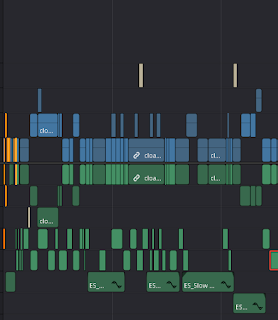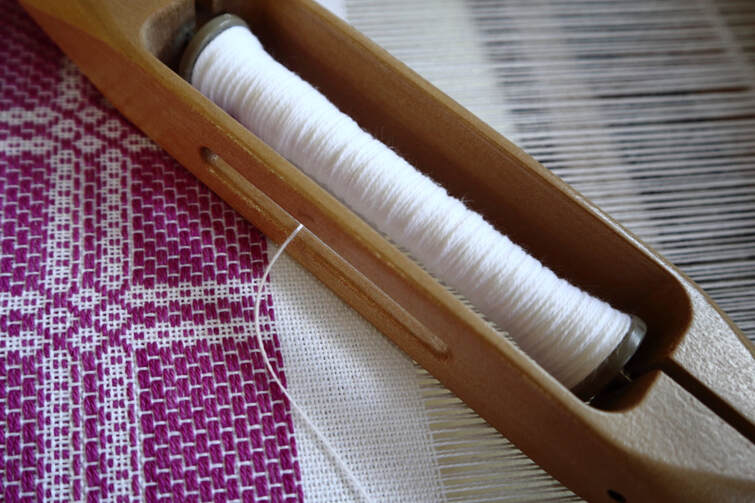Pilfered from my other blog.
Can I borrow your toothbrush?
Not A toothbrush. YOUR toothbrush.
The one you use at least twice a day (and hopefully more). I’ll bring it back tonight, or at least by next week... or soon...ish. Soon-ish. I promise. I know it’s your only toothbrush and you don’t have a chance to go out and get another one because it was a super-deluxe toothbrush you spent years of your life finding the perfect one to fit the shape of your mouth. You don’t mind if I borrow it, right?
It may seem like an unusual request and an even odder analogy to weaving. As a new weaver, I had trouble understanding that silence that invaded the room every time someone asked to borrow (or even touch) a weaving tool. Nearly 20 years later, I’m starting to understand what that bated-breath moment was and why weavers can seem incredibly cold on the idea. And yet...
Weavers are some of the most generous and helpful people in the fibre arts community - and given how amazing all yarn people are, that’s saying something! Weavers are happy to give their time and spend hours troubleshooting in return for nothing more than a cuppa tea. My guild is filled with hundreds of kind-hearted individuals who will drop everything to help a fellow guildmate.
Why then, does the thought of lending tools or sharing studio space send so many weavers running for the hills?
If weaving was a personality, it would be ISTP on the Myers Briggs scale. Introverted, Sensing, Thinking, Perceiving = The Craftsman (or for most of my guild, Craftswoman!). If I was choosing labels, I would call this personality The Artizan. More than a craftsperson, a person with tremendous dedication to improving their skill and attention to detail that doesn’t borderline on the obsessed - it has a fast-pass to that border and spends every second week on the far side of it.
Introverted: Weaving is a solitary craft. Yes, we gather together to share and learn, but then we go home, to our studio, alone. Our looms are generally too big to lug to weave-ins. Spinning, knitting, crochet, and most other fibre arts don’t have this demand for solitary time to be able to accomplish the most simple aspects of their craft. I came from a knitting and spinning background, where weekly meetups for tea, yarn, and society, were standard. It took me a long time to understand why weavers are such isolated animals.
And let’s face it, there’s the counting! I mean, counting to four is hard enough, but some of these drafts require us to count to 10, 20, or over 810 for one pattern repeat. This does not make for a kind reaction to destruction. One error can cause hours of frustration. If we are alone, the only person we can get frustrated at is ourself and life is safer that way.
Sensing: in this instance, sensing is all about noticing the details. I suspect every fibre artist is strong in this area. We absorb the world around us through our senses - all of them - and remember the details. It’s one of the reasons why textures and smells are so important to us when buying yarn.
The texture, shape, feel, smell, and occasionally taste (I only have two hands, two feet, and sometimes I need to hold things in my mouth) is important to us.
Weavers generally take this focus to the extreme. Forest - trees. A weaver has to see both in excruciating detail. Each thread needs to be measured to the centimetre (or better yet, the 1/16th of an inch). We need to be intimately equated with how much pressure and friction we can apply to a warp thread - as an individual and as a group. Not to mention, the precise tolerances of our tools. This precision was never needed in knitting - where the biggest problem I had was whether the yarn would make the cables pop or if it would pill if knit into a sweater.
Thinking: The thinking personalty analyzes the pros and cons, and seeks consistency and logic in decision making. Weaving is all about consistency. There are so many right ways to do a weaving technique, but the only real wrong way to do it is to be inconsistent. Weaving naturally attracts people who adore consistency. I suspect from an outside point of view, moving the weaving bench two inches to the left isn’t going to be a big deal. But to a weaver, that is a massive deal as it will change the shape of the cloth. Inconsistency in the placement of the tools means the weaver will change their behaviour to accommodate, which changes the finished fabric.
The cloth reflects the moment. This is known in every historical weaving tradition, from the Cowichan people on the West Coast of Canada to the Irish Linen weavers who wove in dark, stone cottages. SAORI weaving technique embraces this understanding that cloth is like a river. Capture that moment and flow in time, and it can never be repeated. Be it our mood, the humidity, the pinched nerve while sneezing, the placement of the tools - weaving is capturing and trapping the moment as the weft is locked into the warp.
But for most weavers, we strive against this. We seek consistency in our work. We often struggle to keep out the influences of the moment and the person, and this too is part of the Thinking element of this personality type.
Perceiving: The balance to perceiving on the Myers Briggs scale, is ‘judging’. And I wonder how to say this without defaulting to the “not a cat” definition of dog. These are both about how we analyze information. Judging likes to put the information in boxes that gives the information value. This was a good thing, that was a good meal, this crosswalk isn’t pedestrian-friendly.
Perceivers are less about organizing where the information belongs and more about accepting it. A thing happened. I ate a meal. Oh, that car almost hit me, I will be more careful in that crosswalk in future. Often the two styles of processing information assume the other style is the same as them. Conflict happens when Judging style assumes the perceiving style assigns moral meaning to each item. The perceivers can’t imagine that anyone would, or even could, file information into groups like that.
Most weavers I know prefer to take in information rather than spend time sorting it into categories. If something happens, no one has to be to blame. We simply look at the situation and see if there is something we can try to prevent it in the future. If the shuttle drops. That’s what happened. The solution is to try different throwing, or bobbin winding, or beaming techniques until we find the way that works. There is too much to do to waste time categorizing events into judgement boxes.
Interesting. But what’s this got to do with toothbrushes?
You remember the toothbrush? I’m honoured. And surprised anyone made it this far.
Introverted, Sensing, Thinking, Perceiving
As an introverted craft, we are used to working alone. Without help.
Actually, between you and me, most “help” isn’t. It’s not that it’s unwanted, it’s that it usually comes without asking. People assume they are helping, and they don’t stop to ask first.
But if someone was willing to ask first, that would be helpful. The SCA (Society for Creative Anachronism) taught me one important thing above all else - Always be willing to offer help, and Always be able to accept no as an answer. Once you get weaving a while and get to know the community, it’s evident that there is no moral value or judgement assigned to the word “no”). They just didn’t need help at that moment in time. But they might later.
Weavers tools, and by extension the placement of them in the studio, are acquired and perfected over decades. Each tool is chosen because it is a perfect match for the weaver, and for many weavers, that means using irreplaceable antique (more than 100 years old) tools. As the weaver uses the tool, it adapts to their body - like a gold fountain pen nib adapts to the writer - and can be majorly messed up when used by someone with a different slant.
Each tool has associated with memories. This loom belonged to so-and-so who wove the most amazing such-and-such and died at the ripe age of 96. This warping mill was made by this famous maker, and the repairs were done by... I got that shuttle from the fibre festival where so-and-so had a heart attack and was saved by ... These scissors are the only heirloom I have from Strawberry Grandma, my great grandmother, and was given to her as a graduation gift, by her aunt who bought them in Portugal in the 1880s. They are the best darn scissors I’ve ever had, and I don’t want them messed up by cutting paper as they are a pain in the ass to sharpen.
Each tool has many hours invested in choosing, repairing, and maintaining. Each and every tool in a studio is an extension of the weaver’s true self. To borrow a toothbrush is nothing compared to borrowing a weaving tool.
Lending a toothbrush may mean nothing more than having someone use it for a photograph. Or they may brush their teeth with it. They may, out of kindness, clean it under boiling water, melting the bristles. Or they may just use it to clean the toilet. To lend a toothbrush not knowing what will happen to it while absent, nor how long it will stay away, would be folly.
But that’s a rubbish analogy. Weaving tools are nothing like a toothbrush. They are far more sacred.
As a new weaver, it took me a while to learn that lending tools was an issue. So many weavers have more than one of a thing just so they can lend out their extra for people just getting started. But many weavers don’t have the space. Their basement isn’t brimming over with spare weaving tools. They streamline and keep just enough space and tools to fulfil their personal weaving needs. These people are more cautious about lending tools. They tend to set little tests with small things before they are willing to let go of the big things.
What worked for me was to listen to the weaver and repeat back what I understood so that my mentor could understand that I absorbed the information. More importantly, that I was willing to treat their tool as they wanted, not the way I thought it should be treated. Small tests would be made to see how good I was at respecting the weaver and their idiosyncracies. Sometimes I passed, and sometimes I didn’t. The worst times were when I tried to be helpful by repairing something - that wasn’t actually broken!

























